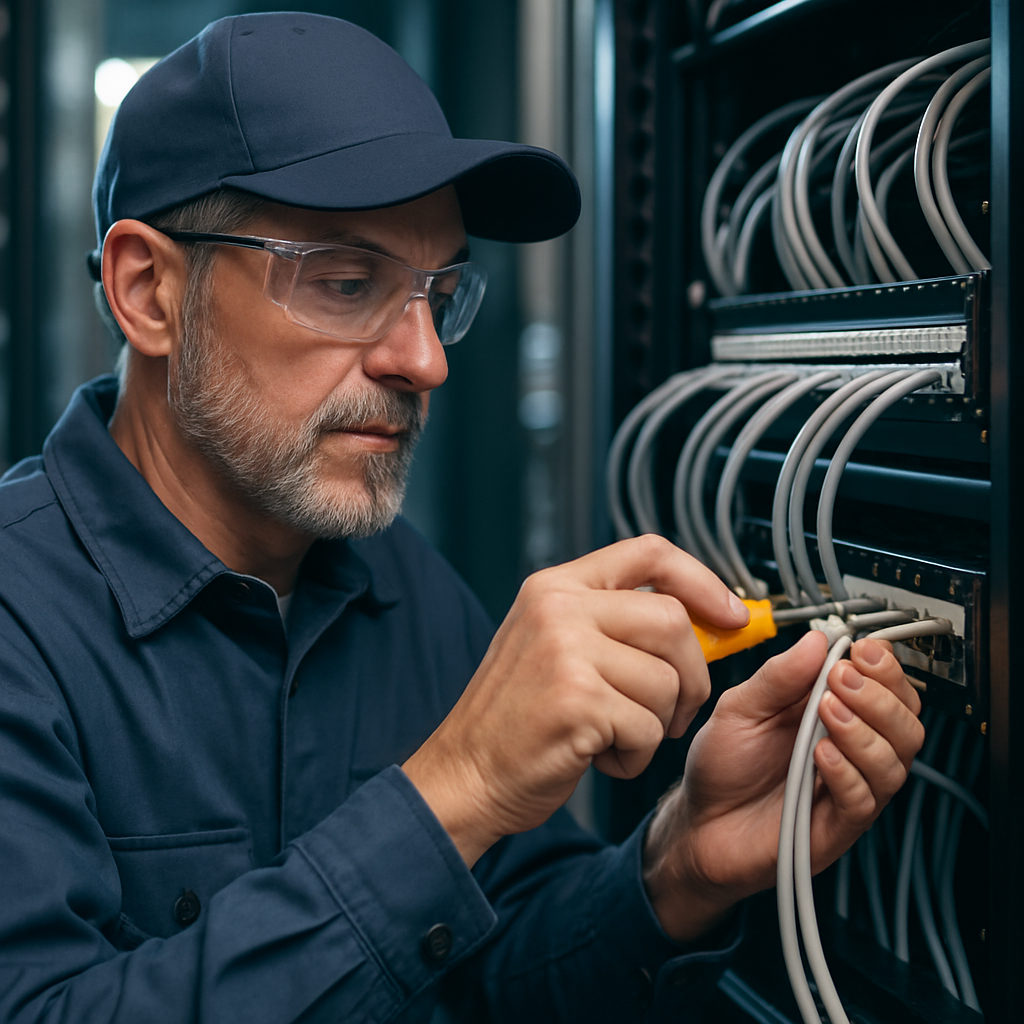4 min read
Network Patch Panel in Structured Cabling System: A Guide for Data Centers
A disorganized data center rack full of tangled network cable runs is a direct liability to your network's stability. When cables used for...
4 min read
Turn-key Technologies Staff : Jan 3, 2024 4:55:17 PM
Coaxial cables play a crucial role in modern networks, specifically in structured cabling systems. These cables come in various types, each with its own unique characteristics and applications. Understanding the different types of coaxial cables used in structured cabling is essential for professionals in the field.
Coaxial cables are a type of electrical cable that is commonly used in structured cabling systems. These cables consist of a central conductor, which is surrounded by a dielectric insulator, a metallic shield, and an outer insulating jacket. The design of coaxial cables allows for the transmission of high-frequency signals with minimal interference.
One of the key features of coaxial cables is their ability to carry signals over long distances without significant loss in signal quality. This makes them ideal for applications that require reliable and high-performance data transmission, such as in telecommunications, cable TV, and computer networking.
In structured cabling systems, coaxial cables are often used to connect various devices, including computers, routers, switches, and televisions. They provide a reliable and efficient means of transmitting data, voice, and video signals.
Overall, understanding the basics of coaxial cables is essential for anyone involved in structured cabling installations and maintenance. By knowing how these cables work and their advantages, professionals can ensure optimal performance and reliability in their network infrastructure.
Coaxial cables offer several benefits when used in structured cabling systems. One of the main advantages is their high bandwidth capacity, which allows for the transmission of large amounts of data at high speeds.
Another benefit of coaxial cables is their excellent shielding capabilities. The metallic shield surrounding the central conductor provides protection against electromagnetic interference (EMI) and radio frequency interference (RFI), ensuring that the signals transmitted through the cables remain clear and unaffected.
Additionally, coaxial cables are known for their durability and reliability. They are designed to withstand harsh environmental conditions, such as extreme temperatures and moisture, making them suitable for both indoor and outdoor applications.
Furthermore, coaxial cables are versatile and can be used for various purposes, including data transmission, video surveillance, and cable TV distribution. Their compatibility with different devices and systems makes them a popular choice in structured cabling installations.
In summary, the benefits of coaxial cables in structured cabling include high bandwidth capacity, excellent shielding capabilities, durability, and versatility. These features make coaxial cables an essential component of modern network infrastructure.
There are several different types of coaxial cables used in structured cabling systems, each with its own characteristics and applications.
One common type is RG-6 coaxial cable, which is widely used for cable TV and satellite TV installations. It has a larger diameter and lower loss compared to other coaxial cables, making it suitable for long-distance transmissions.
Another type is RG-59 coaxial cable, which is commonly used for CCTV systems and video surveillance. It has a smaller diameter and higher loss compared to RG-6, but it is still capable of transmitting video signals over relatively short distances.
RG-11 coaxial cable is another type that is typically used for high-bandwidth applications, such as in data centers and large-scale networks. It has a larger diameter and lower loss than both RG-6 and RG-59, allowing for the transmission of signals over longer distances.
Apart from these, there are also specialized coaxial cables designed for specific applications, such as RG-8 for radio frequency (RF) communications and RG-213 for high-power transmissions.
Understanding the different types of coaxial cables is crucial for selecting the appropriate cable for a specific structured cabling installation. It ensures optimal performance and compatibility with the devices and systems being used.
Coaxial cables find numerous applications in structured cabling systems, thanks to their unique characteristics and capabilities.
One of the primary applications is in cable TV distribution. Coaxial cables are used to transmit TV signals from a central source, such as a cable TV provider, to individual households. The high bandwidth capacity and excellent shielding of coaxial cables ensure clear and reliable TV reception.
Another common application is in computer networking. Coaxial cables can be used to connect computers, routers, switches, and other network devices, enabling the transmission of data between them. They provide a stable and secure connection, making them suitable for both residential and commercial network installations.
Coaxial cables are also widely used in video surveillance systems. They allow for the transmission of high-quality video signals from security cameras to recording devices or monitors. The durability, shielding capabilities, and long-distance transmission capability of coaxial cables make them an ideal choice for CCTV installations.
Furthermore, coaxial cables are used in telecommunications, particularly for voice and data transmission. They are employed in telephone networks and internet service provider (ISP) setups to connect customers to the network infrastructure.
Overall, the applications of coaxial cables in structured cabling are diverse and encompass various industries and sectors. Their versatility, reliability, and performance make them an integral part of modern network infrastructures.
When installing coaxial cables in structured cabling systems, it is essential to follow best practices to ensure optimal performance and reliability.
One important practice is to avoid sharp bends or kinks in the cables. Coaxial cables are sensitive to physical stress, and bending them too tightly can cause signal loss or damage to the cable itself. It is recommended to use gentle curves and cable management solutions to maintain the integrity of the cables.
Proper grounding is another crucial aspect of coaxial cable installation. The metallic shield of coaxial cables serves as a ground, and it should be properly connected to the grounding system of the building or facility. This helps prevent the buildup of static electricity and reduces the risk of electrical surges or interference.
Maintaining the correct cable lengths is also important. Coaxial cables have specific signal loss characteristics based on their length, and exceeding the recommended lengths can result in degraded signal quality. It is essential to measure and cut the cables accurately to ensure optimal performance.
Lastly, it is advisable to label and document the coaxial cable connections. This makes it easier to identify and troubleshoot any issues that may arise in the future. Proper documentation also helps with cable management and future maintenance.
By following these best practices, professionals can ensure that coaxial cables are installed correctly and function effectively in structured cabling systems, providing reliable and high-performance data transmission.
With our expertise in structured cabling, we provide comprehensive services across NJ, NYC, and PA, guaranteeing that your setup adheres to the most stringent standards in the industry.

4 min read
A disorganized data center rack full of tangled network cable runs is a direct liability to your network's stability. When cables used for...

What’s the cost of a messy cable setup? When cables are crammed, mislabeled, or routed poorly, systems overheat, repairs take longer, and downtime...

6 min read
A high-performance network is built on thousands of precise details, but few are more critical than the termination point. A flawless cable run can...